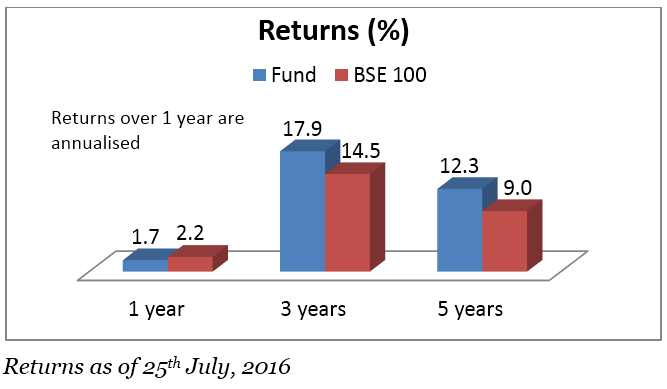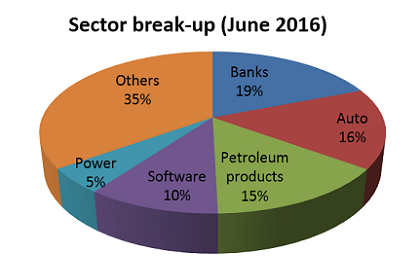Are swift rises and steep falls in the stock market and your fund’s returns not your cup of tea? In that case, a fund that can strategically get into cash depending on market conditions can suit you. Invesco India Dynamic Equity can put up to 30 per cent of its portfolio into debt or cash based on market volatility. In the equity portion, it invests only in blue chips. It keeps the volatility in returns low, and sports a good record of consistently beating the BSE 100 index.
Staying steady
Invesco India Dynamic Equity uses both cash and derivatives to manage volatility, switching out of equity when markets are heated. This strategy keeps the impact of a market fall to a minimum. In the uncertain markets of 2013, for example, while the BSE 100 index (the fund’s benchmark) and the large-cap fund category lost around 12 per cent, Invesco India Dynamic Equity lost just 1.9 per cent. The fund cut equity exposure from over 90 per cent in mid-2012 to 77 per cent by February 2013, and further to 72 per cent by August. Similarly, in the 2011 slide, the fund’s losses were 2-3 percentage points better than the market and category.
Of course, this also limits gains. The fund did increase its equity holdings towards the end of 2013. But it held this exposure at around 84 per cent throughout 2014, on account of the swift market run. It matched its benchmark’s return in the 2014 uptrend, but fell short of peers’ returns. Holding debt while the market is still good removes a part of the gains that other equity funds will earn. Similarly, in the sharp rally from March this year to now, the fund’s 10 per cent return is lower than the BSE 100’s 13.1 per cent return. Keeping its equity allocation at 72-80 per cent has hurt its returns, even pulling the one-year return below the benchmark.
But over a longer period, the fund has beaten the BSE 100 consistently. Rolling three-year returns since its inception shows the fund beating the BSE 100 index over 90 per cent of the time. In the three and five-year periods, the fund has beaten the benchmark by three percentage points. It has the lowest volatility compared to large-cap funds. Further, on the risk-adjusted return metric, the fund is nearly at the top of the pack.

Invesco India Dynamic Equity is similar to ICICI Prudential Dynamic Plan, which also takes tactical asset allocation calls. The ICICI fund invests across market capitalisations, including mid-cap stocks, against the Invesco fund’s large-cap holding. This certainly serves ICICI Pru Dynamic better during bull markets, and it has thus beaten Invesco India Dynamic Equity on the returns front. But the Invesco fund scores much better on both volatility and risk-adjusted returns, which is what a dynamic asset allocation aims for.
Therefore, while it will not deliver chart-topping high returns, Invesco India Dynamic Equity is a steady performer that suits conservative investors. Given its strategy, and that it is an equity fund, it requires a long-term holding period.
Compact portfolio
Apart from sticking to large caps, Invesco India Dynamic Equity holds only around 15-20 stocks in its portfolio. It takes relatively concentrated bets in its top holdings. Because of its moves in and out of equity, the fund’s portfolio turnover is on the higher side. Sector weights too shift quickly, depending on where the fund has pruned its holding. This is one fund where banking is not the steady top holding.

Over the past year, the fund had a sizeable exposure to the petroleum sector, which paid off as stocks such as BPCL, HPCL, and IOCL gained sharply. The fund has recently trimmed exposure to this sector. Also seeing a cut was software. Pharmaceuticals also saw a steep drop in portfolio share over the past year. Instead, the fund has bought into automobiles through stocks such as Mahindra & Mahindra and Hero MotoCorp. It has also slightly raised its exposure to private sector banks. The fund’s current portfolio appears to be a balanced mix of cyclical and consumer themes, allowing it to benefit from a more broad-based economic and market recovery.
The fund’s AUM, while on the lower side at Rs. 131 crore, has shot up from the Rs. 56 crore it was in June last year. The fund is managed by Vetri Subramaniam.
FundsIndia’s Research team has, to the best of its ability, taken into account various factors – both quantitative measures and qualitative assessments, in an unbiased manner, while choosing the fund(s) mentioned above. However, they carry unknown risks and uncertainties linked to broad markets, as well as analysts’ expectations about future events. They should not, therefore, be the sole basis of investment decisions. To know how to read our weekly fund reviews, please click here.







